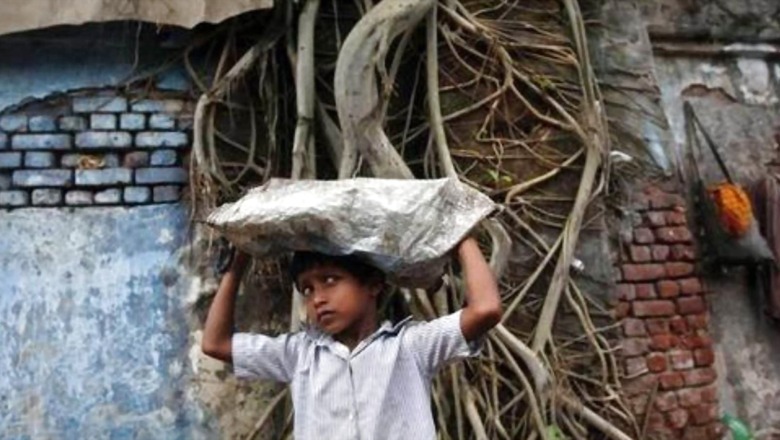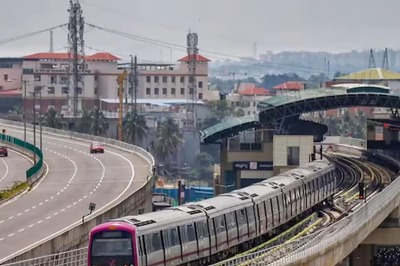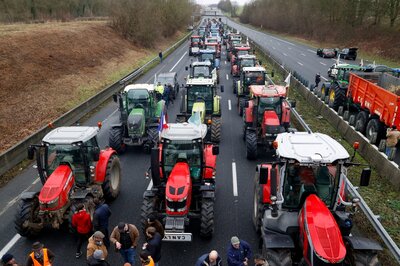
views
In the year 2022, labour and civil society organisations and governments stand at a critical juncture — only three years remain to achieve the Sustainable Development Goal 8.7 (to take immediate measures to eradicate forced labour) of eliminating all forms of child labour by 2025.
Child labour not only violates the rights of children but also remains among the worst forms of violence against them. To imagine a just, egalitarian and compassionate world, the shackles of slavery and bondage, depriving millions of children of laughter, happy childhood and education, need to be broken. As the international community observes the World Day Against Child Labour 2022 on June 12, it becomes extremely important to identify the challenges and find lasting solutions to end the menace of child labour.
According to an International Labour Organisation (ILO) report, the number of child labourers across the globe has increased to 160 million in 2021. In the last four years, 8.4 million children were forced to work, while around nine million children are at risk of being made child labourers because of the pandemic, the report states.
The ILO’s simulation model adds a note of caution: in the absence of social protection coverage, the number of child labourers could increase to 46 million because of the pandemic.
India is among the countries having a significant number of child labourers. “Substantial variation in child labour estimates exists across the South Asian countries. In absolute terms, child labour in 5-17 age group is highest in India (5.8 million), followed by Bangladesh (5 million), Pakistan (3.4 million) and Nepal (2 million),” says another ILO report titled ‘Child Labour in South Asia’.
According to the 2011 census data, the number of working children in the age group of 5-14 years was 1.01 crore (10.1 million). A report from Kailash Satyarthi Children’s Foundation, after considering the rate of child labour population in the last four decades, says the total child labour population in the country will reach 81.2 lakh by 2021 and then decline to 74.3 lakh by 2025.
A misconception still exists that poverty is the sole reason for child labour. When, in fact, there are other reasons for children being forced to work as well. This includes the lack of quality education and the absence of a social security and protection net.
The reasons for child labour and its multiple repercussions received a broader, cohesive and collective engagement in 1998. This was the year when Nobel Peace Laureate Kailash Satyarthi organised the Global March Against Child Labour. The march, which was organised across 103 countries covering a distance of around 80,000 km, saw the participation of over 70 lakh people. Culminating at the annual conference of ILO in Geneva on June 6, 1998, the march had urged the ILO to accede to its two-fold demand: one, international law be formed against child labour, and two, a day to be recognised as against child labour.
Subsequently, the ILO adopted the new international law (ILO Convention No. 182) to protect children from worst forms of child labour and recognised June 12 as the World Day Against Child Labour.
India ratified the convention in 2017. Earlier in 2016, the Union government amended the Child and Adolescent Labour (Prohibition and Regulation) Act (CLPRA), 1986. Other government measures to tackle the issue of child labour include the National Child Labour Project Scheme (NCLP) and the launch of the Platform for Effective Enforcement for No Child Labour (PENCIL) portal.
But achieving the SDG of eliminating child labour by 2025 remains a mammoth task.
According to the National Crime Record Bureau 2020 data, a total of 1,712 FIRs were registered under the amended Child Labour (Prohibition and Regulation) Amendment Act. The pencil portal, since its launch in 2017, has identified over 1.97 lakh child labourers.
What is then the way forward? The vision for a child-friendly world, free from child labour must begin with a resolute time-bound action plan now. Participation of Civil Society Organisations with the government, effective implementation of existing regulations, creating awareness among people and sensitising the Law Enforcement Agencies (LEAs) can be the first step.
Next, special programmes can be launched for income generation in the source states of child labour. Once the children employed in labour are rescued, there should be viable rehabilitation models. A key element here is not only enrolling these children in school but providing them with quality education as well. This will create a new generation of employable and empowered children, free from the vicious trap of bondage and servitude.
As the country makes a renewed commitment to end child labour by 2025, let us not forget the contribution of one man who changed the destinies of scores of marginalised and deprived child labourers — Kailash Satyarthi. The mainstream integration of the issue of child labour and child exploitation — otherwise a forgotten footnote of society — was pioneered by Satyarthi, who under the aegis of Bachpan Bachao Andolan (BBA) back in 1980, launched the crusade against child labour.
The credible study from Kailash Satyarthi Children’s Foundation reveals that to eliminate child labour by 2025, the decline in the number of child labour must increase from the existing 1.9 lakh per annum to 12.4 lakh per annum. The study states that the present efforts have to be scaled up seven times while simultaneously focusing on other critical components such as budgetary outlay, manpower along with social and political commitment that ought to be increased exponentially.
The author is a documentary filmmaker, photographer and independent researcher and writer. The views expressed in this article are those of the author and do not represent the stand of this publication.
Read all the Latest News , Breaking News , watch Top Videos and Live TV here.


















Comments
0 comment